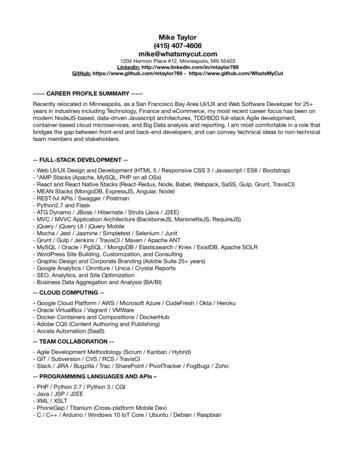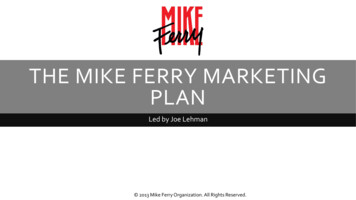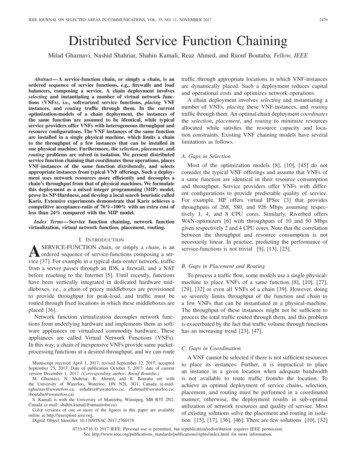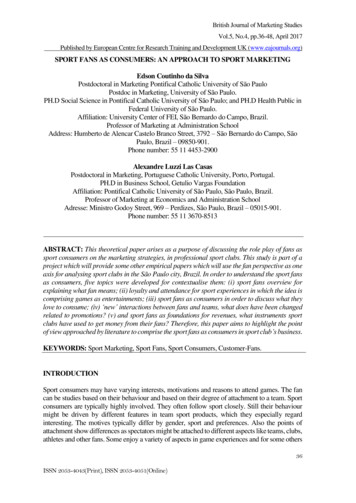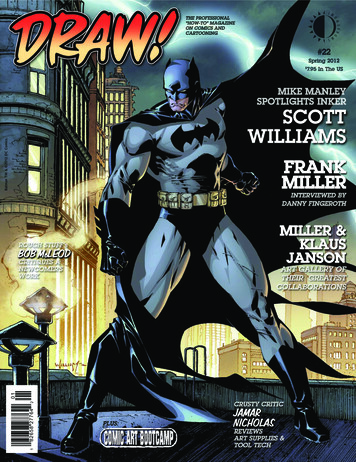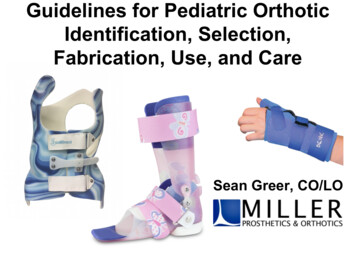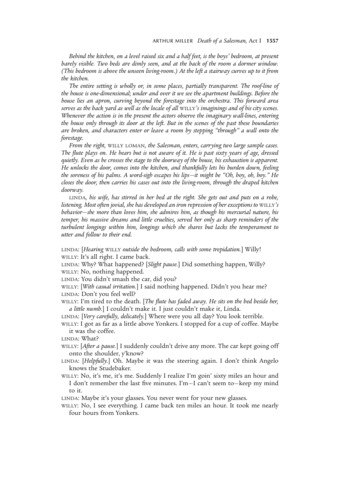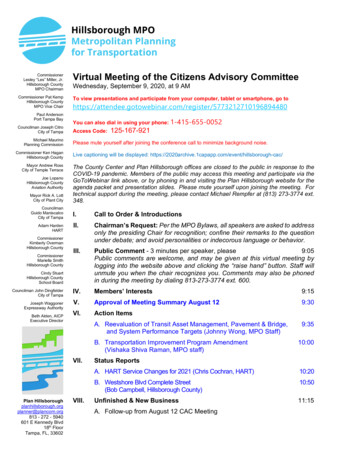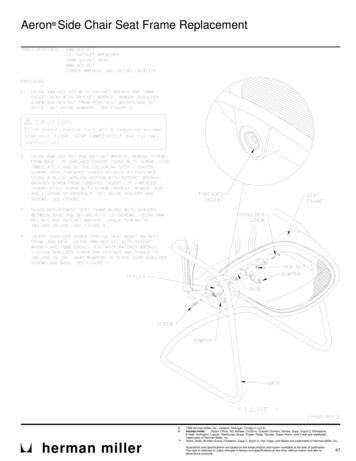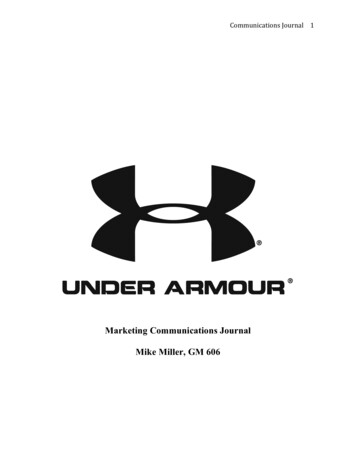
Transcription
CommunicationsJournal1Marketing Communications JournalMike Miller, GM 606
CommunicationsJournal2Table of Contents1.Executive Summary2.Context Analysisa. Customer Contextb. Business Contextc. Internal Contextd. External Contexte. Main Communication Needs3.Marketing Communications Goals and Positioninga. Corporate Objectivesb. Communication Objectives4.Segments, Targeting and Position (STP)5.Marketing Communications Strategy6.Message and Creative7.Coordinated Communications Mix (Messages, Tools & Media)a. Social Mediab. Onlinec. Television8.Resourcesa. Humanb. Financial9.Scheduling and Implementation10.Issues11.Evaluation and Control12.Feedback13.Conclusion and Summary14.Appendix15.Resources
CommunicationsJournal3Executive summaryAs the name indicates, Under Armour is an athletic apparel company that was built on theconcept of creating superior base layer apparel that acts as a performance enhancer for seriousathletes. Created by Kevin Plank, a former college football player at the University of Maryland,Under Armour has experienced exponential growth since it was founded in 1996 in Baltimore.The Under Armour story is a simple one, one where “two guys (Plank and his friend andcompany COO, Kip Fulks) working day and night in the basement of Plank’s grandmother’shouse, stitching and shipping their groundbreaking tight-fitting and sweat-wicking shirts” growfrom initial revenues of 17,000 in 1996 to 1.8 billion as of 2012” (Burke, 2013). The littlecompany with a great core idea of creating “cutting-edge products for the next generation and forathletes who compete at the highest level" (UA Brady, 2010) is already a success story but UnderArmour is not content with complacency.The unique, humble origins history of Under Armour is an influencing aspect of the direction ofthe brand. Athlete-driven innovation is at the core of everything the company does and thatmessage is clearly and directly given through all levels of their marketing communicationstrategy. As such, the initial target audience of hard-core, hard-working, male athletes waslargely inspired by the former division 1 football player and founder Plank who “emits hisbrand’s energy and its chip-on-the-shoulder vibe” (Burke, 2013). This target audience helpedUnder Armour develop their niche market but recent campaigns have directly targeted newsegments in women and youth through a variety of communication tools (see Appendix 1) andintegrated marketing campaigns while always focusing on the driven athlete.For this Communications Journal, I chose Under Armour because of their recent launch of theirbiggest global advertising to date, the #IWill campaign (see Appendix 2). In it, I analyzed three
CommunicationsJournal4specific communication tools that Under Armour used: social media, internet/microsites andtelevision. Across these channels, Under Armour is able to reach old and new targets alike but,most importantly, on a global level. Through the hard-work and strategic decision-making ofPlank, Under Armour has gained a reputation for delivering on performance enhancingequipment, achieved through relentless innovation, and all their marketing tools relay thisreputation. Before taking on Under Armour, I had only a passive relationship with the brand, hadnever received communications from them and I had no idea of the size and scope of theirpresence or vision. After research it is clear that at the core of all decision-making, UnderArmour targets athletes with the aim of helping and inspiring them to perform at their best.Context AnalysisCustomer ContextUnder Armour clearly defines its target consumers as athletes and, as a high involvement brand,it makes sure to “present (their) products in a frame of mental presence that is recognized by abuyer” (Fill, 5). The creative messaging is like their gear, built almost exclusively for sessions inthe gym or on the practice field” (Korman, 2013) and thus showcases the athlete using theapparel in training or during an high intensity competition. Unlike low involvement brands thatsuggest little purchasing risk, thus thought, Under Armour customers have social risk of notbeing seen as serious athletes if their training apparel can be found to be lacking. Additionally,the high price points for Under Armour products convey differentiation of their high tech,performance tested products. Whether the consumer is an a male is male or female, a seriousathlete or a casual exercisers, it is difficult not to be influenced by the powerful messaging of thein-your-face ad campaigns like the well-known "protect this house" battle cry (Zmuda, 2013)that featured muscular athletes introducing Under Armour to the general public in fearless
CommunicationsJournal5fashion. Regardless of location, consumers are educated and they know that wearing this brandconveys a certain message that, if worn, should be continued in the product user. The ultimatedecision maker has to weigh the options of price and an understanding of how to properly use thehigh tech apparel but ultimately, the decision will be primarily influenced by the message given,and personally felt, by wearing Under Armour.Business ContextUnder Armour has one key objective, growth. Promoting innovation remains the key concept ofall messaging but it is clear that Under Armour wants to grow and it has been successful (seeAppendix 3). The company has set high standards in the industry but they remain a distantsecond to Nike, their key competitor and the company they aspire to be. Nike is a bigger, moreglobally established and recognizable sports apparel brand that is focused on performance thathas “annual sales of about 25 billion worldwide compared to Under Armour's 2012 sales of 1.8 billion (Mihoces, 2013). “Positioning is about visibility and recognition of what anorganization brings to a buyer (Fill, 10), but unlike Under Armour, Nike has is well positioned indifferent segments, both in regards to global position and target audience. To add insult, Nikewas named by Fast Company as “the most innovative company of 2013” which, to an innovationbased company like Under Armour, which wasn’t on the innovative list, is a problem. Nike is agiant competitor that is future focused but Under Armour, like the city of Baltimore it represents,likes the underdog role.With a strong American base, “a clear, consistent positioning” (Fill, 11) with athlete inspiredinnovation and a defined and growing target audience, Under Armour has plenty of room forgrowth. “Nike executives are undoubtedly watching carefully” (Burke, 2013) as Under Armourexpands through product innovation, like the Armour39 which seem to target the Nike FuelBand
CommunicationsJournal6(see Appendix 4), creating flagship brand houses, branching into more everyday clothing andlarge-scale global advertising campaigns. Under Armour is attempting to create a moreapproachable brand that speaks to the target audience and no longer alienates secondary targets.Using the specific athlete enhancing niche it began with, and expanding the Under Armour brandwith the more universal #IWill campaign, as it has already started with targeted and countryspecific social media presence (see Appendix 5), Plank is slowly building the brand awarenessacross all the right channels and Nike needs to be ready.Internal ContextThe Under Armour culture is framed by its brand mission: “to make all athletes better throughpassion, design and the relentless pursuit of innovation” (UA.com, 2013). This mission is whatdrives the company but it is in conjunction with the ‘rags-to-riches story’ lived by the founderPlank. Under Armour seeks athlete ambassadors that illustrate this “take-nothing-for-granted”backgrounds like undrafted NFL running back Arian Foster or Tom Brady who, according toPlank, “represents a lot of what Under Armour is all about. He's humble and hungry andcontinues to be focused on winning and getting better every single day” (UA Brady, 2010).Signing strategic, brand-building athletes is important for Under Armour since it doesn’t havethe budget of Nike. As the company grows, it makes sure not to go with the “keep it the sameapproach (Fill, 14) since the goals are long-term. This organizational identity aligns from brandambassadors (Fill, 30) to employees to the CEO and is a vital aspect Under Armour identity.External ContextAs Under Armour has grown; it has continually engaged in intensive, continuity fueled“relationship marketing” (Fill, 7) through partnerships that have helped build the brand whilealso positioning itself for future success. For example, Under Armour has contracts with the
CommunicationsJournal7many college football conferences, like the ACC, SEC, Big12, WAC, it has been the supplier ofcleats for the since 2006 (UA Fact Sheet, 2007) and it sponsors various professional sports teamslike the hometown 2013 Super Bowl champion Baltimore Ravens. Additionally, Under Armourhas connected the brand to many social causes (see Appendix 6) that serve to position the brandfavorably in the minds of consumers and within the industry alike while maintaining the positionof being athlete focused while conveying the “resolve to do the right thing” (Fill, 4).Main Communication NeedsAnalysis of the customer, business, internal and external contexts of Under Armour shows astrong communication strategy that is consistent across all channels. In order to sustain growthgoals, Under Armour must continue to focus on non-traditional consumers, like women or nichemarkets like hunters, and international markets. Under Armour is poised for success and at thecore, the unique humble, tough and innovation fueled message must continue to be delivered.Marketing Communication Goals and PositioningThe Under Armour overarching objective is to use passion, design and innovation to makeathletes better but the current focus is growth. According to the CEO, "in the year ahead, UnderArmour will drive growth by re-invigorating core categories, continuing to expand our consumerbase in Women's and Youth, and introducing the next wave of Under Armour innovation throughproduct such as Armour39, open the next generation of Under Armour specialty retail in midFebruary in our home city of Baltimore, while prioritizing our growth strategies in key marketsin Europe, Asia, and Latin America” (UA 4th Quarter Reports, 2013). Under Armour has aclearly defined mission and communications strategy that work together to deliver on theprimary object of growth. From what I’ve seen, especially in conjunction with the large-scaleglobal #IWill advertising campaign further support the strategic direction of Under Armour.
CommunicationsJournal8Segments, Targeting and PositioningUnder Armour segments target audiences, athletes, by gender, age, sport, niche interest andgeography. The typical Under Armour consumer persona has always been the young, athleticmale athlete aspires to use intense training to achieve hard-earned success. This consumer createstime focus on bettering himself through practice, doesn’t take shortcuts and thus earns athleticsuccess, much like brand ambassadors Tom Brady and Arian Foster, both of whom overcameadversity to make it to NFL stardom. Today’s version of this consumer is media savvy, watchesESPN, aspires to perform like professional heroes and, as such, must wear the same performanceenhancing workout gear. That said, Under Armour is now targeting similarly driven athleteprofiles across in various regions, genders and ages and the #IWill campaign is the first step.Marketing Communications StrategyAs Under Armour continues to evolve it’s consumer base through a global marketing strategy,using tools such as social media, online and television, a key goal is building brand awareness.Whether in new markets, or previous markets where Under Armour is known as a male-orientedapparel company, the company needs to promote their new, more inclusive image. As a result,Under Armour is utilizing pull-positioning, push-positioning and-profile positioning; otherwiseknown as the 3P’s of marketing communications strategy. New products, like Armour39, requirea pull-strategy of purchase driven communication but Under Armour must also operate a pushstrategy that aims to “develop relationships and distribution networks” (Fill, 10) as the companytargets international growth. Lastly, Under Armour is intent on building a new reputation thathighlights the changing, broader image so a profile-positioning strategy is also being used.Message and CreativeUnder Armour has a history of being direct with its messaging and creative but as of February
CommunicationsJournal912, when Under Armour launched the global #IWill campaign, the overall messaging andcreative operate been unified across all platforms around this new advertising strategy. Thecampaign represents a major investment for the Under Armour but, “given the brand’s salesgrowth, spending about 20% over a year ago” (Zmuda, 2013). To put it into a financialperspective, Under Armour spent about 12 million on measured media in the first three quartersof last year, according to Kantar Media. To put it simply, Under Armour is expecting big thingsout of the messaging and creative #IWill campaign.Coordinated Communications MixSocial MediaTo drive the #IWill campaign directly to consumers, Under Armour used social media as aprimary marketing communications tool. Under Armour wants consumers to be able to interactwith the brand, whether it is posting comments on the Facebook wall or replying to theconstantly updated twitter feed, and as such as put a focus across social networks and digitalplatforms. Under Armour is active with the #IWill campaign their main Facebook, Twitter andYouTube sites (see Appendix 7). The lone exception is Google but it is apparent that the site isnot viewed with much importance as updates have stopped as of November 2012. All of thesemain Under Armour sites also serve the purpose of driving consumers back to UA.com
Context Analysis Customer Context Under Armour clearly defines its target consumers as athletes and, as a high involvement brand, it makes sure to “present (their) products in a frame of mental presence that is recognized by a buyer” (Fill, 5). The creative messaging is like their gear, built almost exclusively for sessions in the gym or on the practice field” (Korman, 2013) and thus .
